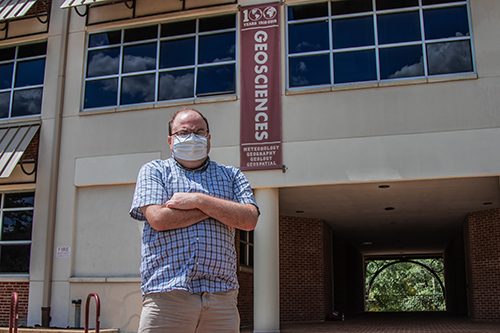Balancing risks of pandemic versus severe weather: MSU grad student examines shelter use during COVID-19
Contact: Sarah Nicholas

STARKVILLE, Miss.—The severe weather outbreak on Easter Sunday has inspired a Mississippi State doctoral student to examine how the public approaches severe weather preparedness while also balancing COVID-19 concerns.
Craig D. Croskery, a Ph.D. student in earth and atmospheric sciences in MSU’s Department of Geosciences, said his personal experience April 12 in a local safe room—seeking safety from eminent tornadoes near the start of the coronavirus pandemic—was the motivating factor for launching his dissertation research on how the general population makes physical safety decisions amidst competing risk factors.
“I had a video taken in the shelter that received nationwide media exposure and it became clear that this was a valuable case study,” Croskery said. “[My work] will help determine if we can be motivated to shelter even during a pandemic, let alone in normal times.”
Croskery said dealing with multiple threats at one time creates “difficult decisions and balancing risks.” He said individuals must “determine the element of risk involved and whether it is more beneficial to take shelter even if it means being close together.”
During hurricane season, Croskery said people might have to take shelter for an extended period if a hurricane threatens to make landfall.
“In addition, hurricanes do spin up occasional tornadoes, and while they are usually weak, they can still be very dangerous—especially to residents in mobile homes,” Croskery said.
“My personal belief is that the risks need to be weighed against each other. I believe that the risk of severe injury and death from a significant tornado is much higher than from COVID-19. We don’t know in real time if a tornado will be weak, strong or violent, hence we must always plan for the worst,” Croskery said.
For those deciding to take shelter in a community safe room, Croskery suggested, “Wear masks and gloves, carry along spray and wipes and get there early so you can find a place to spread out. Once back home, take a shower immediately.”
Croskery said he has seen the pandemic motivate “personal solutions,” such as families purchasing in-house shelters, which saved lives in the violent southern Mississippi tornadoes, even when houses were completely destroyed. However, Croskery said not all families can afford a private shelter.
To gather data for his dissertation, Croskery developed a survey to learn how respondents have reacted to tornado warnings this spring and whether or not their responses are different during the time of a pandemic compared to other years.
A native of Canada, Croskery received his bachelor’s degree at Carleton University in Ottawa, Canada and his master’s degree from MSU.
Croskery will submit his research results to the Department of Geosciences by the end of July with intentions to have his work peer reviewed. He also will seek publication in a meteorology journal with hopes that his research may impact standard operating procedure.
MSU’s College of Arts and Sciences includes more than 5,200 students, 325 full-time faculty members, nine doctoral programs, 14 master’s programs, and 27 undergraduate academic majors offered in 14 departments. For more details about the College of Arts and Sciences or the Department of Geosciences visit www.cas.msstate.edu or www.geosciences.msstate.edu.
Mississippi’s leading university, also available online at www.msstate.edu.